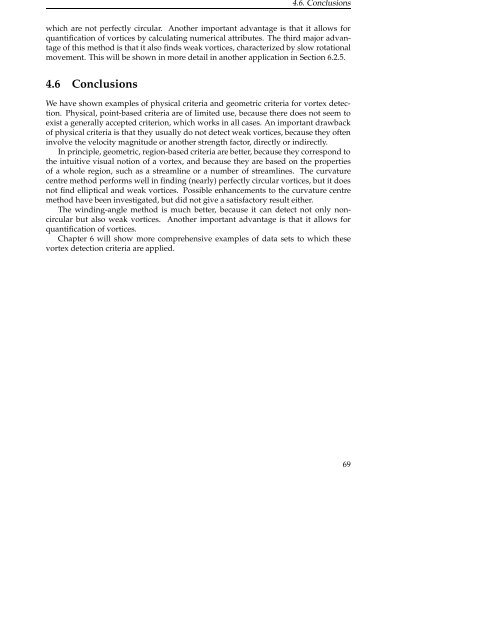Chapter 4 Vortex detection - Computer Graphics and Visualization
Chapter 4 Vortex detection - Computer Graphics and Visualization
Chapter 4 Vortex detection - Computer Graphics and Visualization
You also want an ePaper? Increase the reach of your titles
YUMPU automatically turns print PDFs into web optimized ePapers that Google loves.
4.6. Conclusions<br />
which are not perfectly circular. Another important advantage is that it allows for<br />
quantification of vortices by calculating numerical attributes. The third major advantage<br />
of this method is that it also finds weak vortices, characterized by slow rotational<br />
movement. This will be shown in more detail in another application in Section 6.2.5.<br />
4.6 Conclusions<br />
We have shown examples of physical criteria <strong>and</strong> geometric criteria for vortex <strong>detection</strong>.<br />
Physical, point-based criteria are of limited use, because there does not seem to<br />
exist a generally accepted criterion, which works in all cases. An important drawback<br />
of physical criteria is that they usually do not detect weak vortices, because they often<br />
involve the velocity magnitude or another strength factor, directly or indirectly.<br />
In principle, geometric, region-based criteria are better, because they correspond to<br />
the intuitive visual notion of a vortex, <strong>and</strong> because they are based on the properties<br />
of a whole region, such as a streamline or a number of streamlines. The curvature<br />
centre method performs well in finding (nearly) perfectly circular vortices, but it does<br />
not find elliptical <strong>and</strong> weak vortices. Possible enhancements to the curvature centre<br />
method have been investigated, but did not give a satisfactory result either.<br />
The winding-angle method is much better, because it can detect not only noncircular<br />
but also weak vortices. Another important advantage is that it allows for<br />
quantification of vortices.<br />
<strong>Chapter</strong> 6 will show more comprehensive examples of data sets to which these<br />
vortex <strong>detection</strong> criteria are applied.<br />
69

















